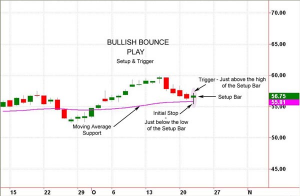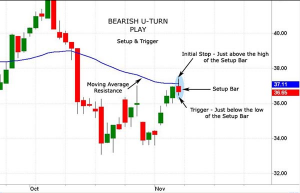The Bullish Bounce & Bearish U-Turn are powerful Stock Trading Tactics for both good and bad markets.
Whenever the market rolls over into a “dip,” most investors are inclined to focus on why it happened. Though I’m always curious about the reasons behind a pullback, as a trader I’m more interested in the potential profits to be gained from the price movement. This means viewing any move as a pathway to another profitable stock trade setup.
Realizing the power of momentum associated with trend, I prefer to enter trades in the same direction as the primary trend for the time frame I’ve chosen to trade. And being somewhat risk averse, I also prefer to anticipate price levels where positions can be entered in stocks with very low risk. Because of this preference I lean toward trades that are likely to take place near support or resistance levels.
Bounces and reversals rank high on the RightLine list of set-ups to trade. My two personal favorites in this group are the “Bullish Bounce” and the “Bearish U-Turn.” Both of these trades provide excellent profit opportunities, yet they don’t require you to be directionally biased or to act on “blind faith” – the belief that the market is “definitely” going to move favorably.
The “Bullish Bounce”
This stock trade Set-up first looks to determine the current trend, and as the name implies, the trend has to be bullish. Once the strength of the trend is confirmed, we will watch for a normal pullback to take place. There are certain criteria that qualify the pullback as “normal.” Included is the distance the stock drops in proportion to price, and the length of time it takes to complete the decline.
The final and most important requirement for a Bullish Bounce set-up is determined by how the stock price reacts when it comes in contact with a support level, such as a specific moving average. The preferred reaction occurs whenever price dips to the support level during intra-day trading, then reverses and moves up a certain percentage of the day’s high-to-low range.
Once the Bullish Bounce Setup is in place, we want to see a confirming sign that the previous upward trend is about to resume. This is usually a price move that takes out a short-term technical resistance level, such as the high of the Set-up day, and should normally occur within one or two days after the Set-up day. That move is our signal to immediately enter the stock. Once a position is bought, we always place an Initial Stop for protection, and then follow up with a Trailing Stop as the trade moves favorably.
Here is an example of a Bullish Bounce Play setup:

The “Bearish U-Turn”
Similar to the Bullish Bounce, this stock trade looks for a strong trend. However, instead of an upward, bullish trend, the Bearish Setup looks for a downward price trend. Once the trend is confirmed, we wait for a normal rise to take prices back up to a selected moving average, which serves as resistance. Just as in the Bullish bounce, the criteria for “normal rise” includes the distance the stock rises in proportion to price, and the length of time it takes to complete the move up to the chosen resistance.
The most important aspect of a Bearish U-Turn set-up is determined by how the stock price reacts when it comes in contact with the resistance level, the specific moving average. The preferred reaction takes place when the stock rises to the resistance level during intra-day trading, then reverses and moves down a certain percentage of the day’s high-to-low range.
Once the “Bearish U-Turn” Setup is in place, we watch for a confirming sign that the previous downward trend is about to resume. This is usually a stock price move that takes out a short-term technical support level, such as the low of the Set-up day. This move will normally occur within a day or two after the Set-up day. The move is our signal to immediately place an order to sell the stock short. Once a position is entered, we always place an Initial Stop for protection, and then follow up with a Trailing Stop as the stock trade moves favorably.
Another positive aspect to both of these trades is the tendency for the stock price to gain momentum as it moves away from the point of entry. They often become positive very quickly, allowing the initial stop to be moved to the break-even level. At this moment the position essentially becomes a “free” trade with no risk of loss – as long as the stop is only moved in the direction of the profit.
Here is an example of a Bearish U-Turn Play setup:

Bottom line: These types of reversal stock trades provide excellent opportunities when filtered through the RightLine Risk Control Calculator. Be sure to watch for Bullish Bounce and Bearish U-Turn stock trades in each issue of the RightLine Report. They’re certainly among my favorite stock setups, and I suspect you will like them too.






